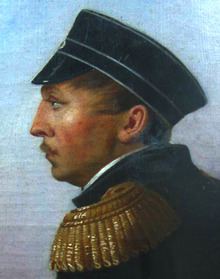Allegiance Russia Role Naval Officer | Name Pavel Nakhimov Years of service 1818–1855 Rank Admiral | |
 | ||
Commands held Corvette NavarineFrigate PalladaShip of the line SilistriaShip Brigade of Black Sea FleetChief of Fleet DivisionSquadron of Black Sea FleetCommander of Fleet and Port Battles/wars Battle of NavarinoRusso-Turkish War (Dardanelles blockade)Battle of SinopSiege of Sevastopol Assassinated July 12, 1855, Sevastopol, Ukraine Similar People Mikhail Kutuzov, Vladimir Alexeyevich Kornilov, Vladimir Istomin, Fyodor Ushakov, Nicholas I of Russia | ||
How to pronounce pavel nakhimov russian russia pronouncenames com
Pavel Stepanovich Nakhimov (Russian: Па́вел Степа́нович Нахи́мов, [ˈpavʲɪl sʲtʲɪˈpanəvʲɪtɕ nɐˈxʲiməf]) (July 5 [O.S. June 23] 1802 – July 12 [O.S. June 30] 1855) was one of the most famous admirals in Russian naval history, best remembered as the commander of naval and land forces during the Siege of Sevastopol during the Crimean War.
Contents
- How to pronounce pavel nakhimov russian russia pronouncenames com
- Biography
- Ships named after Nakhimov
- Honours and awards
- References
Biography
Born in the Gorodok village of Vyazma uyezd (district) of Smolensk Governorate. Nakhimov entered the Naval Academy for the Nobility (Morskoy Dvoryanskiy Korpus) in Saint Petersburg in 1815 . He made his first sea voyage in 1817, aboard the frigate Feniks ("Phoenix"), to the shores of Sweden and Denmark. Soon afterwards he was promoted to the rank of non-commissioned officer. In February 1818 he passed examinations to become a midshipman and was immediately assigned to the second Fleet Crew (Flotskiy Ekipazh) of the Russian Imperial Navy's Baltic Fleet.
At the beginning of his naval career, Nakhimov's experience was limited to the voyages in the Baltic Sea and a more extensive trip from the White Sea port of Arkhangelsk to Kronstadt naval base near St. Petersburg. His lucky break came in March 1822, when he was assigned to the frigate Kreiser ("Cruiser"); the vessel took part in a round-the-globe expedition commanded by well-known Russian explorer Mikhail Petrovich Lazarev, who had already undertaken several such voyages.
During the three-year voyage, Nakhimov was promoted to the rank of lieutenant. On conclusion of this adventure, he received his first award, the Order of Saint Vladimir IV degree.He returned to his native Smolensk and was assigned to the 74-gun warship Azov, which made its maiden voyage from Arkhangelsk to Kronstadt in autumn of 1826.
In the summer of 1827, Azov sailed to the Mediterranean as flagship of the Russian squadron under command of Rear-Admiral Lodewijk van Heiden for a joint expedition with the French and British navies against the Ottomans. Just before departure, Azov was visited by Tsar Nicholas I, who ordered that in the case of hostilities, to deal with the enemy "as the Russians do."
Azov, under then-Captain First Rank M.P. Lazarev, most distinguished itself in the 1827 Battle of Navarino, at which the allied British-French-Russian fleet totally destroyed the Ottoman fleet. For his outstanding gunnery performance during the battle, Nakhimov was promoted at the age of 27 years to the captaincy of a trophy ship and was decorated by the allied governments.
During the Crimean War Nakhimov distinguished himself by annihilating the Ottoman fleet at Sinope in 1853. His finest hour came during the siege of Sevastopol, where he and Admiral V. A. Kornilov organized from scratch the land defense of the city and its port, the home base of the Russian Black Sea Fleet. As the commander of the port and the military governor of the city, Nakhimov became in fact the head of the Sevastopol naval and land defense forces. On July 10 [O.S. June 28] 1855, while inspecting the forward-defense positions on Malakhov Kurgan he was fatally wounded by a sniper and died two days later.
Nakhimov was buried inside St Vladimir's Cathedral in Sevastopol along with Mikhail Lazarev, V.A. Kornilov and Vladimir Istomin. There is a monument erected in his memory. The Soviet government presented other posthumous honors as well--Nakhimov Naval Schools were introduced for teenagers, and the Order of Nakhimov (with two degrees) and the Nakhimov Medal were established for Navy personnel. The Order of Nakhimov was preserved as one of the highest military decorations in Soviet Union and, upon its dissolution, in Russia.
